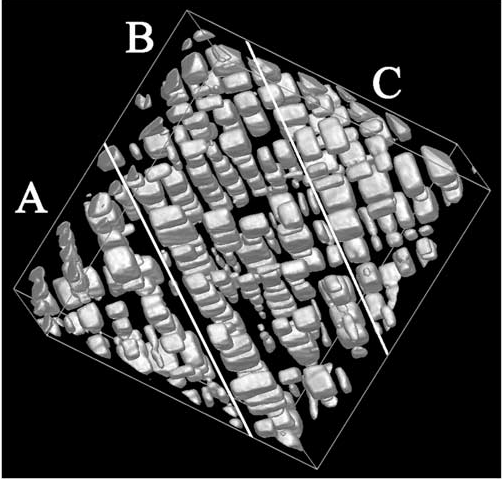|
|
The Problem/Challenge we pose is: when, where, and how does oxidation initiate in these materials and what atomistic scale features
facilitate the (early stage) growth of the oxide?
 The NiCrAl alloy has L12-ordered precipitates in a disordered fcc matrix. Depending upon details of heat treatments different, typically
complicated structures with these precipitates are formed - many of the details are known in the literature, for instance
the reconstruction of cuboidal precipitates from the group of Voorhees shown on the right. The precipitates has a L12 structure, for small sizes
or short aging times it is coherent with the disordered fcc matrix. At longer times, the precipitates, usually possessing plate-like morphologies, have
semicoherent interfaces with the matrix. There may also be carbide precipitates depending upon exactly what composition is used.
The literature on superalloys is fairly large but due to the complexity of commercial superalloys, it is unclear the generality of the oxidation results.
Extensive research on local chemical ordering as well as investigations of deformation processes have been performed and
as well as recent progress in understanding for the morphology evolves from APT experiments although how this relates to early-stage oxidation is unclear.
In addition, many of the experimental results are older and newer methods have not as yet been used to study all the details.
The NiCrAl alloy has L12-ordered precipitates in a disordered fcc matrix. Depending upon details of heat treatments different, typically
complicated structures with these precipitates are formed - many of the details are known in the literature, for instance
the reconstruction of cuboidal precipitates from the group of Voorhees shown on the right. The precipitates has a L12 structure, for small sizes
or short aging times it is coherent with the disordered fcc matrix. At longer times, the precipitates, usually possessing plate-like morphologies, have
semicoherent interfaces with the matrix. There may also be carbide precipitates depending upon exactly what composition is used.
The literature on superalloys is fairly large but due to the complexity of commercial superalloys, it is unclear the generality of the oxidation results.
Extensive research on local chemical ordering as well as investigations of deformation processes have been performed and
as well as recent progress in understanding for the morphology evolves from APT experiments although how this relates to early-stage oxidation is unclear.
In addition, many of the experimental results are older and newer methods have not as yet been used to study all the details.
|
 NiAl Superalloys
NiAl Superalloys
 NiAl Superalloys
NiAl Superalloys